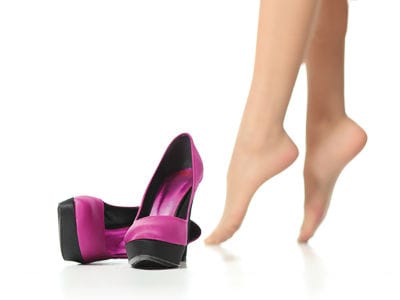In a cartoon set in a shoe museum, two women stare at an exhibit that traces the Chinese tradition of foot binding. “What could be more inhumane,” asks one of the women, balancing precariously on six-inch stilettos.
The irony, of course, is that modern women inflict their own foot injuries in the name of beauty, and are perfectly happy to squeeze their feet into shoes that are too tall, too pointy, too flimsy and too tight.

“Women know that certain shoes are bad for them, but they don’t realize the potential for permanent injury to the foot,” says Dr. Deborah Lynn Ackland, a podiatrist in Greenwood, NS.
According to Dr. Ackland, the first step to good footwear and healthy feet is a proper fit. “In my personal experience,” she says, “many people wear shoes of the wrong size.”
Unfortunately, ill-fitting shoes cause more than discomfort—especially for women with a genetic predisposition toward foot disorders. Shoes that are too tight can result in conditions ranging from blisters, calluses and corns (a build up of skin on the sides and bottom of the feet) to fungal infections, knee problems and deformed toes. Shoes that are too loose and wide are no better. They allow the foot to slide around, causing a build up of calluses under the ball of the foot, while shoes that are too narrow create a hard ridge of calluses at the edge of the foot.
“Look at the foot bed of your shoes,” advises Dr. Ackland. “For a proper fit, the foot bed should be shaped like your foot and have a toe box [the area of the shoe where the toes lie] with ample room. Squeezing the toes into a short, shallow toe box may alter their alignment.”
One of the first things Dr. Ackland does when assessing new patients is measure their feet. “Both of their feet,” she explains. “It isn’t enough to measure just one foot, because it’s common for people to have one foot that’s slightly larger than the other.”
For a comfortable fit, podiatrists recommend that shoes be 12 to 15 millimetres longer than the longest toe. And don’t assume the big toe is the longest. In some cases that honour goes to the second toe.
People are accustomed to fluctuations in the size of their clothes, yet often believe that their shoe size remains static. “Not so,” says Dr. Ackland. “Feet change over time, and it’s not uncommon for people to go up a shoe size as they age or gain weight.”
Like many women, Dr. Ackland wears high heels, but only on occasion and never when she has to walk any distance. “I find them uncomfortable,” she says, “so if I wear them out for dinner, I usually slip them off under the table.”
For heel height and style, the safest options are a height of no more than four centimetres and broad-based heels made from shock-absorbing materials like rubber. “High heels tilt the weight of the body onto the ball of the foot,” explains Dr. Stephen Hartman, CEO of the Canadian Federation of Podiatric Medicine. “The higher the heel, the more unstable the shoe.”
Twists, sprains and breaks are the obvious dangers associated with unstable footwear, yet according to Dr. Hartman, it’s actually repetitive micro-traumas such as strained muscles and tears to fibres and tissue that pose a more serious threat and may, in time, cause permanent injuries.
“I don’t have the numbers to prove it,” he says, “but from years of experience as a podiatrist, I can safely say that women are far more likely than men to have foot conditions that are either caused or exacerbated by the shoes they wear. Part of that comes down to heredity, and the fact that women are more flexible than men, but wearing the wrong footwear has a significant impact.”
As with many things in life, moderation is the key.
“I try not to talk women out of wearing the wrong kind of shoes,” says Dr. Hartman, “but I do encourage them to wear them less often, to reduce the height of the heels, and to avoid walking in them for any distance. People often return from vacation with foot problems because they’ve walked longer than they anticipated in dress shoes and flip-flops.”
Both Dr. Hartman and Dr. Ackland agree that flip-flops are often the cause of foot troubles.
“It’s best to avoid any shoes that are hard to keep on your feet,” says Dr. Ackland. “Flip-flops keep your feet cool, but the benefit ends there. They offer nothing in the way of protection, support, or shock absorption, and are really only suited for a short stroll on the beach.”
It shouldn’t come as any surprise that matching shoes with specific activities is considerably more important than matching them to the colour and style of an outfit. Still, there are some activities that challenge, and sometimes defeat, even the soundest of footwear.
As Dr. Ackland’s daughter—and a long-time competitive runner who participates in ultra-marathons—London, UK-based barrister, Sacha Ackland, should have the inside track when it comes to finding the right athletic footwear. But in the past two decades she has suffered from athlete’s foot, fungal nails, blisters, metatarsal stress fractures and lost toenails.
“There’s no doubt that running is hard on the body,” says Sacha. “I think Mum is horrified and fascinated in equal measure by what I do to my feet. On the bright side, I make a very good case study.”
How to be well-heeled
Described by Leonardo da Vinci as a masterpiece of engineering and a work of art, the human foot is a complicated shock absorber consisting of 26 bones, 33 joints and more than 100 tendons, muscles and ligaments. Like any complex mechanism, it has great potential for problems, especially with Atlantic Canada’s aging population.
“Most people take more than 5,000 steps a day, so selecting the right kind of footwear is very important,” says Dr. Hartman. “You can get away with wearing all sorts of shoes when you’re young, but the older you get, the more important it is to wear solid shoes with a closed heel or a retaining medium like a back strap.”
According to Dr. Hartman, arch support is a key consideration when shopping for footwear. Flip-flops and flat ballet styles may be in fashion, but they don’t do your feet any favours when it comes to support, and that can lead to difficulties such as chafing, blistering, fallen arches, overgrowths of the heel bone, called heel spurs, and plantar fascitis—an inflammation of the tissue around the heel of the foot.
He also recommends footwear that breathes. Uppers made from natural materials like leather will allow in some air and reduce moisture, while occlusive (non-breathing) footwear like rubber boots may cause feet to perspire and leave them susceptible to fungal infections.
Exposed toes are more prone to injury, so whether working or playing, it’s wise to protect your feet. Diabetics are especially prone to foot complications, so they should be vigilant in selecting shoes with enough protection to ward off traumas and wounds.
Amid all the cautions and hazards, the positive news for serious shoe lovers is that new shoes are very good for the feet. Not only can they improve problems with gait, they can also alleviate complaints of the back and knees.
“New shoes are definitely recommended,” says Dr. Hartman. “That’s the silver lining in all of this.”
